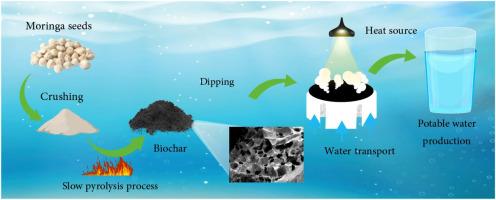Pyrolyzed moringa seed-based photothermal absorber for enhanced solar interfacial evaporation
IF 6.3
2区 材料科学
Q2 ENERGY & FUELS
引用次数: 0
Abstract
Developing cost-effective photothermal materials for solar-driven water evaporation is essential for attaining high evaporation rates with simplicity and affordability, particularly in arid regions. However, the preparation of photothermal materials involves the use of costly materials and complex synthesis procedures, which may limit scalability. This study presents a twofold objective: the use of biomass-based materials as photothermal absorbers and a straightforward preparation method that eliminates the need for costly and complex processes.
The biochar production was optimized at 41.4 % yield when pyrolyzed at 300 °C for 60 min.
The resulting biochar moringa seeds (BMS) were used as a photothermal absorber in the interfacial solar evaporation system. BMS demonstrated impressive water evaporation performance, achieving an evaporation rate of 6.72 kg m−2 h−1 at steady state under infrared light, which represents a 72.75 % improvement compared to untreated cotton (UC). Meanwhile, the moringa seed (MS) and UC cases demonstrated evaporation rates of 4.24 and 3.89 kg m−2 h−1 at steady state, respectively. In terms of thermal performance, the dry BMS case reached a temperature peak of ∼134 °C within 6 min, but the wet BMS reached ∼78.5 °C after 20 min of illumination. This study underscores a sustainable and efficient approach to solar-driven water evaporation by utilizing biomass materials, offering practical applications in water-scarce and arid regions.

热裂解辣木籽光热吸收剂增强太阳界面蒸发
为太阳能驱动的水蒸发开发具有成本效益的光热材料对于以简单和负担得起的方式实现高蒸发率至关重要,特别是在干旱地区。然而,光热材料的制备涉及使用昂贵的材料和复杂的合成过程,这可能会限制可扩展性。这项研究提出了一个双重目标:使用生物质基材料作为光热吸收剂,以及一种直接的制备方法,消除了对昂贵和复杂工艺的需要。在300℃下热解60 min,产率达到41.4%。制备的生物炭辣木种子(BMS)在界面太阳能蒸发系统中用作光热吸收剂。BMS表现出令人印象深刻的水分蒸发性能,在红外光下的稳态蒸发速率为6.72 kg m−2 h−1,与未经处理的棉花(UC)相比,提高了72.75%。同时,辣木种子(MS)和UC种子的稳态蒸发速率分别为4.24和3.89 kg m−2 h−1。在热性能方面,干燥的BMS在6分钟内达到了~ 134°C的温度峰值,而潮湿的BMS在照明20分钟后达到了~ 78.5°C。本研究强调了利用生物质材料的可持续和有效的太阳能驱动水蒸发方法,为缺水和干旱地区提供了实际应用。
本文章由计算机程序翻译,如有差异,请以英文原文为准。
求助全文
约1分钟内获得全文
求助全文
来源期刊

Solar Energy Materials and Solar Cells
工程技术-材料科学:综合
CiteScore
12.60
自引率
11.60%
发文量
513
审稿时长
47 days
期刊介绍:
Solar Energy Materials & Solar Cells is intended as a vehicle for the dissemination of research results on materials science and technology related to photovoltaic, photothermal and photoelectrochemical solar energy conversion. Materials science is taken in the broadest possible sense and encompasses physics, chemistry, optics, materials fabrication and analysis for all types of materials.
 求助内容:
求助内容: 应助结果提醒方式:
应助结果提醒方式:


